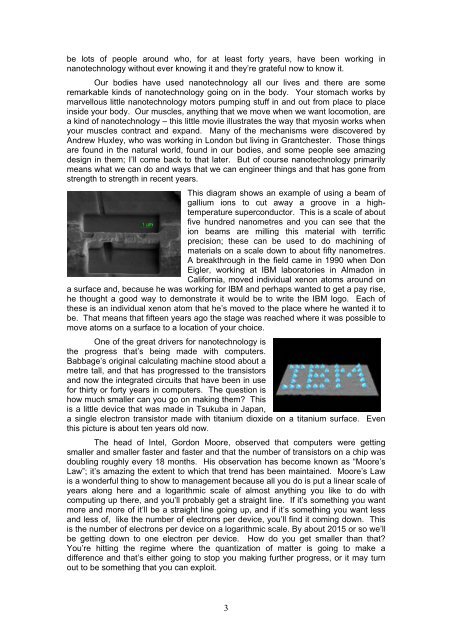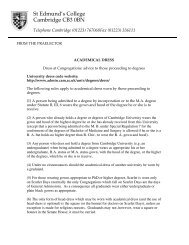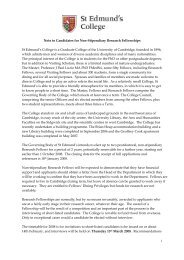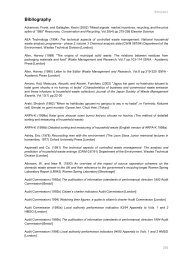Lecture - St Edmund's College - University of Cambridge
Lecture - St Edmund's College - University of Cambridge
Lecture - St Edmund's College - University of Cambridge
You also want an ePaper? Increase the reach of your titles
YUMPU automatically turns print PDFs into web optimized ePapers that Google loves.
e lots <strong>of</strong> people around who, for at least forty years, have been working in<br />
nanotechnology without ever knowing it and they’re grateful now to know it.<br />
Our bodies have used nanotechnology all our lives and there are some<br />
remarkable kinds <strong>of</strong> nanotechnology going on in the body. Your stomach works by<br />
marvellous little nanotechnology motors pumping stuff in and out from place to place<br />
inside your body. Our muscles, anything that we move when we want locomotion, are<br />
a kind <strong>of</strong> nanotechnology – this little movie illustrates the way that myosin works when<br />
your muscles contract and expand. Many <strong>of</strong> the mechanisms were discovered by<br />
Andrew Huxley, who was working in London but living in Grantchester. Those things<br />
are found in the natural world, found in our bodies, and some people see amazing<br />
design in them; I’ll come back to that later. But <strong>of</strong> course nanotechnology primarily<br />
means what we can do and ways that we can engineer things and that has gone from<br />
strength to strength in recent years.<br />
This diagram shows an example <strong>of</strong> using a beam <strong>of</strong><br />
gallium ions to cut away a groove in a hightemperature<br />
superconductor. This is a scale <strong>of</strong> about<br />
five hundred nanometres and you can see that the<br />
ion beams are milling this material with terrific<br />
precision; these can be used to do machining <strong>of</strong><br />
materials on a scale down to about fifty nanometres.<br />
A breakthrough in the field came in 1990 when Don<br />
Eigler, working at IBM laboratories in Almadon in<br />
California, moved individual xenon atoms around on<br />
a surface and, because he was working for IBM and perhaps wanted to get a pay rise,<br />
he thought a good way to demonstrate it would be to write the IBM logo. Each <strong>of</strong><br />
these is an individual xenon atom that he’s moved to the place where he wanted it to<br />
be. That means that fifteen years ago the stage was reached where it was possible to<br />
move atoms on a surface to a location <strong>of</strong> your choice.<br />
One <strong>of</strong> the great drivers for nanotechnology is<br />
the progress that’s being made with computers.<br />
Babbage’s original calculating machine stood about a<br />
metre tall, and that has progressed to the transistors<br />
and now the integrated circuits that have been in use<br />
for thirty or forty years in computers. The question is<br />
how much smaller can you go on making them? This<br />
is a little device that was made in Tsukuba in Japan,<br />
a single electron transistor made with titanium dioxide on a titanium surface. Even<br />
this picture is about ten years old now.<br />
The head <strong>of</strong> Intel, Gordon Moore, observed that computers were getting<br />
smaller and smaller faster and faster and that the number <strong>of</strong> transistors on a chip was<br />
doubling roughly every 18 months. His observation has become known as “Moore’s<br />
Law”; it’s amazing the extent to which that trend has been maintained. Moore’s Law<br />
is a wonderful thing to show to management because all you do is put a linear scale <strong>of</strong><br />
years along here and a logarithmic scale <strong>of</strong> almost anything you like to do with<br />
computing up there, and you’ll probably get a straight line. If it’s something you want<br />
more and more <strong>of</strong> it’ll be a straight line going up, and if it’s something you want less<br />
and less <strong>of</strong>, like the number <strong>of</strong> electrons per device, you’ll find it coming down. This<br />
is the number <strong>of</strong> electrons per device on a logarithmic scale. By about 2015 or so we’ll<br />
be getting down to one electron per device. How do you get smaller than that?<br />
You’re hitting the regime where the quantization <strong>of</strong> matter is going to make a<br />
difference and that’s either going to stop you making further progress, or it may turn<br />
out to be something that you can exploit.<br />
3
















